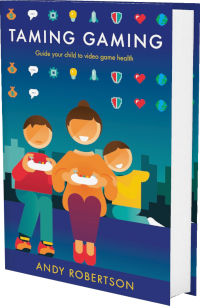 Android
Android iOS
iOS Mac
Mac Switch
Switch Wii
Wii Wii U
Wii U PC
PC PS4
PS4 PS5
PS5 Xbox One
Xbox One Xbox X|S
Xbox X|S17/06/2021 09:02:16 2 years ago Author: Andy Robertson
Some children love video games more than other forms of play. The common thinking is that they were susceptible to the tricks of a powerful industry with coercive technology. They got distracted from healthier hobbies.
I too want my children to have a varied childhood: building dens, individual and team sports, writing and painting, amateur dramatics, ultimate frisbee, playing an instrument, fossil hunting, travelling the world, camping... The list could go on forever. But this doesn’t mean I shouldn’t nurture other things they love, such as video games.
I know that encouraging a child to play video games sounds like a plan to make sure they eat more sweets. But this is about quality, not quantity. Just as we are ambitious for their reading, diet, exercise, education and even film watching, we can be equally ambitious for our children’s gaming to be more than a sugar rush that makes them crazy.
Seeing the families I work with discover the potential of video games and cherishing them as a part of family life – perhaps even as important as mealtimes – is what drove me to write this book. Enabling parents to stop worrying and start guiding gaming in healthy directions is rewarding work because it changes something perceived as negative and scary into something positive and healthy. I want children who love video games to be able to pursue that passion with the transforming ambition, encouragement and cheering-on that parents and guardians uniquely provide.
Caring for a child who loves playing video games includes setting boundaries and helping them balance gaming with other parts of life. But this is not the essence of our care in the long term. Gaming limits are a good short-term framework to enable our involvement, but it’s our presence, attention and wisdom, rather than our monitoring and pestering, that deliver the real benefits.
Our rush to limit screen-time doesn’t match our approach in other areas. We don’t limit a child’s eating time just because they only like one type of food. Instead we worry about what’s on their plate and come up with ever more ingenious ways of getting them to eat vegetables. The primary issue isn’t how long our children spend at the screen, but the quality, texture, content and context of their activity.
Like the effort spent planning, shopping for, cooking and scheduling meals, understanding and guiding gaming takes time and forethought. We need inspiration from recipe books for mealtimes, and I hope that this book can play a similar role in broadening your family’s game time. The parents, carers and children I’ve worked with have found the rewards well worth the effort.
There’s no way to fake this work – discovering for ourselves what games feel like to play, playing games with our children, asking questions about the games they play and listening to their answers.
Kids are brilliant at spotting adults pretending to know or be interested about something. If I’d never eaten vegetables, there is no way I’d have got my kids to eat them. In fact, I made a point of eating them in front of my children when they were younger. I’d demonstrate – complete with yum-yum sounds – that I understand what vegetables are like. If we never play games ourselves, it’s very hard to genuinely guide the children we love in this area of life.
Playing Video Games Ourselves
To care for a child who loves playing video games we need to have played them ourselves. It’s not what parents and carers want to hear, I know that. It sounds like a pain in the rear. But there’s no better way to tame the video games in your family. Grasp this nettle now, particularly if your children are younger, and the flow of games through your home and their lives will be transformed for ever.The nature of games, as a new medium distinct from films and books, means that they can’t be fully understood without experiencing them. If a child was avidly watching cartoons and you’d never seen a cartoon, the best expert advice in the world, or the best scientific reports, couldn’t replace the value of watching some cartoons yourself. You need to experience the emotions they evoke, how they tell stories, handle violence and make you laugh. Cartoons have a different texture and feel to other media. Describing them only gets you so far.
Playing a video game yourself may seem like an impossible and undesirable task. Being a parent or carer is busy enough without another thing to add to the list. Then there’s the level of skill required; how long you need to invest; putting up with the perceived juvenile nature of it all; the embarrassment of being really bad at it; the incessant bright flashing screen and shrill sounds; or the assumption that your child doesn’t want you impinging on their gaming world.
It is hard. But it is important.
With the right advice you can discover games that are mature, easy to play, address themes that interest you and don’t take hours to finish. Games that will reframe what you think of the media beyond Mario Kart, Fortnite or Minecraft. Games that, as I discuss in the next chapter, offer a unique way to experience narratives with emotional involvement, offer fresh perspectives on old subjects, create a context to slow down and relax or enjoy ordering a disordered world.
Yes, that’s right. You, an adult. A busy parent. You, with a list of all the books you want to read and films to watch. You, who are resolutely never going to play video games. There are games that you will enjoy and benefit from playing.
Playing video games yourself can be your secret weapon. Although often it’s not a weapon at all. It’s a secret interactive drama, virtual paintbrush, compass, deck of cards, time machine, backpack, soap opera, hidden camera, blossoming garden, spaceship, instrument, blank canvas or love story.
That’s the mission of this book: offering a concrete and tangible route to tame the gaming in your family by putting games in your hands that you will want to play. Not just because they are valuable or engaging but because experiencing them will transform video game fears and concerns into opportunities and understanding.
Playing Video Games With Our Children
Playing games with your children is easier than playing games on your own. Although parents and carers worry about intruding into their child’s gaming world, or embarrassment at not being able to play very well, children are usually enthusiastic when parents take an interest in the games they are playing.If you aren’t confident or proficient enough to play yourself, sitting with a child and observing what’s going on is a good way to start. Ask questions about what you see. Applaud successes and commiserate with failures. Ask them to show you other games they enjoy, to broaden your understanding.
The parents and carers I work with are often surprised at how transformative their involvement can be. One high profile example is parent and broadcaster Nihal Arthanayake, who I spoke to a couple of times on his BBC 5 Live show. ‘I took your advice on board, so I sit with my son when he plays Fortnite… I have to say that he derives more joy from that experience of being able to share it with me than sitting on his own and doing it… It was an entry into a conversation in his world.’
Establishing this as a long-term sharing of their interest, rather than helicoptering in to check nothing untoward is happening or snowploughing away any dangers, is important. By taking the time to play regularly – no matter how proficient you are – you get to see how video games develop and evolve over weeks and months.
Over the years, playing games together has become part of my family’s rhythm. Like mealtimes and film nights, if we have a day with nothing planned someone will suggest playing a game together. The simple bow-and-arrow combat of Towerfall or the race to balance a stack of blocks in Tricky Towers have us all howling with delight or pain as we win or lose. Or we play a deeper game like My Child Lebensborn on our separate devices and then compare our progress over dinner.
It felt strange at first, putting time and effort into video games that I had previously tried to minimise. But I’m now glad that I did. I’ve worked through the fisticuff adventures of Uncharted with my daughter, gone toe-to-toe for hours with one of my sons in Wii Sports Resort’s table tennis and explored the mysterious underwater worlds of Subnautica with the other. They love escaping into these imaginary worlds with me, and we’ve had some of our most enjoyable conversations while doing it. Sometimes we’ll chat as we play. On other occasions, we share an experience in a game that makes us put the controller down and talk about what just happened.
It’s the kind of sharing we do with books and films, but games are particularly good at crossing the generation gap because, as Steven Johnson puts it, they blur the distinction between children’s and adults’ roles. ‘The kids are forced to think like grownups: analyzing complex social networks, managing resources, tracking subtle narrative intertwinings, recognizing long-term patterns. The grownups, in turn, get to learn from the kids: decoding each new technological wave, parsing the interfaces, and discovering the intellectual rewards of play. Parents should see this as an opportunity, not a crisis. Smart culture is no longer something you force your kids to ingest, like green vegetables. It’s something you share.’
This sharing is much more than passive approval. Your presence in your child’s gaming world fundamentally changes it in powerful and ongoing ways. With you there, children inevitably start seeing it through the eyes of the family. They wake up to the need to evaluate what it is they are playing and become active participants rather than sleeping consumers. Instead of limiting gaming, in the hope that children will learn good habits in a rote manner, playing together actively involves them in forming what James Paul Gee calls an ‘appreciative system’ of the norms that guides their participation.
This is an opportunity for parents to nurture conscious reflection and critique of video games. How do they compare next to other things the family spends its time on? How do games stack up socially, culturally and personally? How do we feel after playing them? Do children like the things they do in the games they play? How harsh or supporting is a particular gaming community? The questions I suggest in each Gaming Inventory are designed to start this process.
This may lead to children stopping playing some games, withdrawing from certain player communities or making more informed decisions about the money they spend on gaming. But equally, it may cause them to spend more time playing to hone skills, develop more structured play patterns or discover new games with more ambitious challenges.
i This article was first published in the Taming Gaming book.
© 2024 Family Gaming Database












